Public Health Informatics Report: Twitter Analysis and Evaluation
VerifiedAdded on 2023/01/11
|5
|1186
|34
Report
AI Summary
This report delves into the field of public health informatics, focusing on the application of information technology, particularly social media, in advancing healthcare. The report begins with an introduction to health informatics and the role of technology, specifically Twitter, in disseminating health-related information. The core of the report involves an analysis of three Twitter accounts: @UKHIP, @pahowho, and @TheMarmotReview. The analysis includes a summary of their activities, frequency of posts, content, and overall impact on public health awareness. The report then explores the competencies, barriers, and limitations of using social media in public health, discussing technical, professional, and legal aspects. It also examines the strengths and weaknesses of Twitter as an ICT tool, considering factors such as cost-effectiveness and trustworthiness. The report concludes with suggestions for the future use of Twitter in public health and overall recommendations for effective implementation of health informatics.
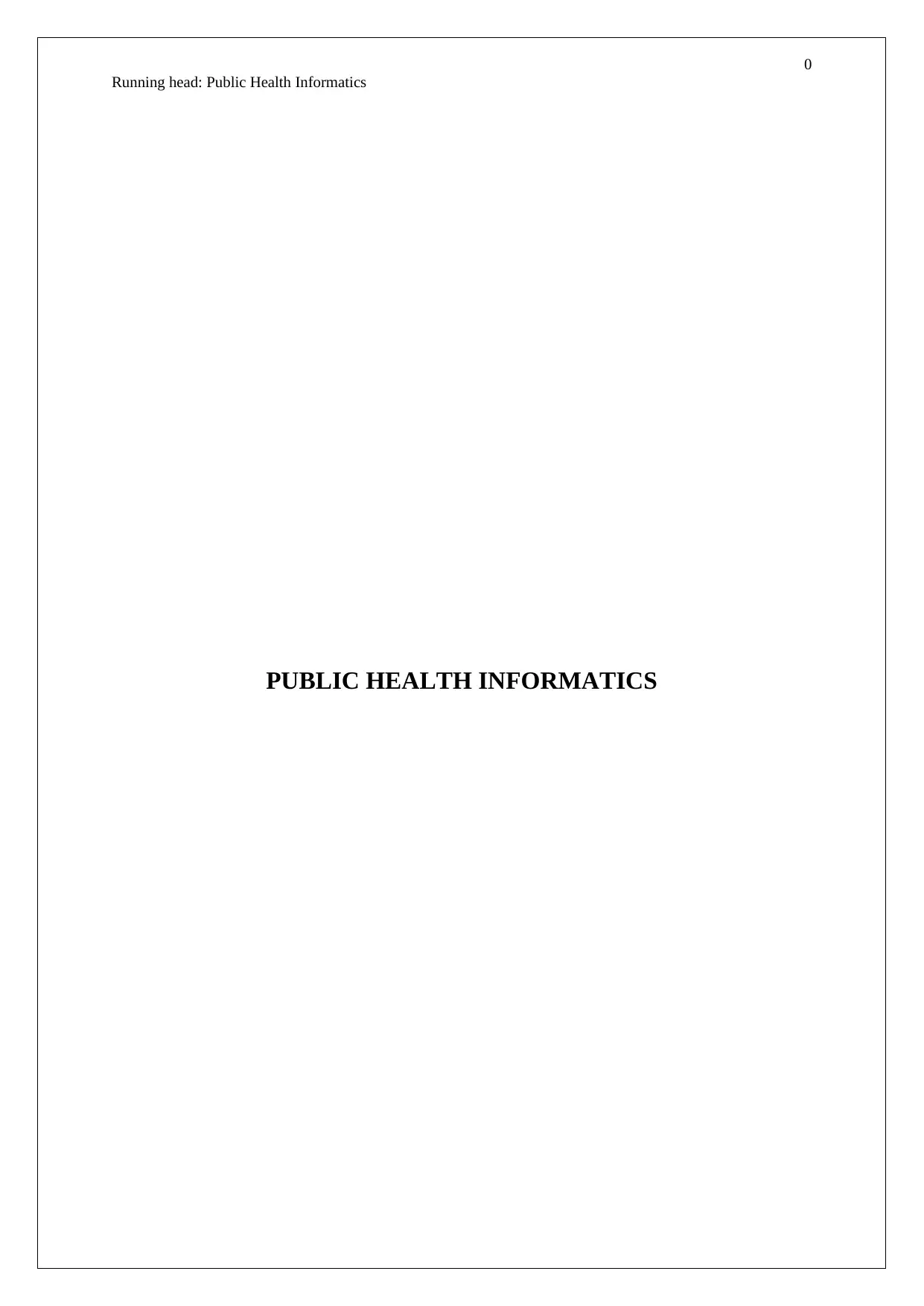
0
Running head: Public Health Informatics
PUBLIC HEALTH INFORMATICS
Running head: Public Health Informatics
PUBLIC HEALTH INFORMATICS
Paraphrase This Document
Need a fresh take? Get an instant paraphrase of this document with our AI Paraphraser
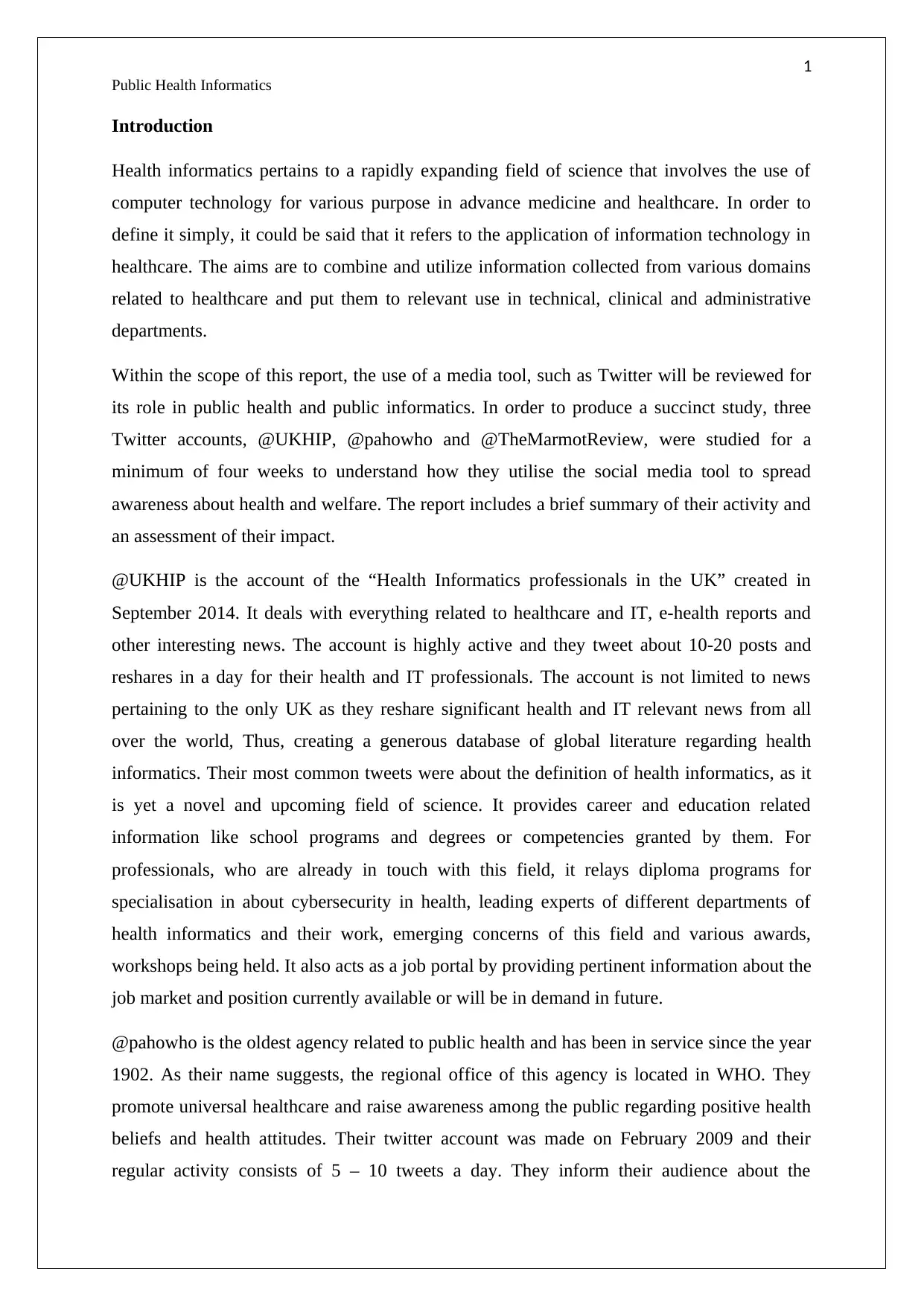
1
Public Health Informatics
Introduction
Health informatics pertains to a rapidly expanding field of science that involves the use of
computer technology for various purpose in advance medicine and healthcare. In order to
define it simply, it could be said that it refers to the application of information technology in
healthcare. The aims are to combine and utilize information collected from various domains
related to healthcare and put them to relevant use in technical, clinical and administrative
departments.
Within the scope of this report, the use of a media tool, such as Twitter will be reviewed for
its role in public health and public informatics. In order to produce a succinct study, three
Twitter accounts, @UKHIP, @pahowho and @TheMarmotReview, were studied for a
minimum of four weeks to understand how they utilise the social media tool to spread
awareness about health and welfare. The report includes a brief summary of their activity and
an assessment of their impact.
@UKHIP is the account of the “Health Informatics professionals in the UK” created in
September 2014. It deals with everything related to healthcare and IT, e-health reports and
other interesting news. The account is highly active and they tweet about 10-20 posts and
reshares in a day for their health and IT professionals. The account is not limited to news
pertaining to the only UK as they reshare significant health and IT relevant news from all
over the world, Thus, creating a generous database of global literature regarding health
informatics. Their most common tweets were about the definition of health informatics, as it
is yet a novel and upcoming field of science. It provides career and education related
information like school programs and degrees or competencies granted by them. For
professionals, who are already in touch with this field, it relays diploma programs for
specialisation in about cybersecurity in health, leading experts of different departments of
health informatics and their work, emerging concerns of this field and various awards,
workshops being held. It also acts as a job portal by providing pertinent information about the
job market and position currently available or will be in demand in future.
@pahowho is the oldest agency related to public health and has been in service since the year
1902. As their name suggests, the regional office of this agency is located in WHO. They
promote universal healthcare and raise awareness among the public regarding positive health
beliefs and health attitudes. Their twitter account was made on February 2009 and their
regular activity consists of 5 – 10 tweets a day. They inform their audience about the
Public Health Informatics
Introduction
Health informatics pertains to a rapidly expanding field of science that involves the use of
computer technology for various purpose in advance medicine and healthcare. In order to
define it simply, it could be said that it refers to the application of information technology in
healthcare. The aims are to combine and utilize information collected from various domains
related to healthcare and put them to relevant use in technical, clinical and administrative
departments.
Within the scope of this report, the use of a media tool, such as Twitter will be reviewed for
its role in public health and public informatics. In order to produce a succinct study, three
Twitter accounts, @UKHIP, @pahowho and @TheMarmotReview, were studied for a
minimum of four weeks to understand how they utilise the social media tool to spread
awareness about health and welfare. The report includes a brief summary of their activity and
an assessment of their impact.
@UKHIP is the account of the “Health Informatics professionals in the UK” created in
September 2014. It deals with everything related to healthcare and IT, e-health reports and
other interesting news. The account is highly active and they tweet about 10-20 posts and
reshares in a day for their health and IT professionals. The account is not limited to news
pertaining to the only UK as they reshare significant health and IT relevant news from all
over the world, Thus, creating a generous database of global literature regarding health
informatics. Their most common tweets were about the definition of health informatics, as it
is yet a novel and upcoming field of science. It provides career and education related
information like school programs and degrees or competencies granted by them. For
professionals, who are already in touch with this field, it relays diploma programs for
specialisation in about cybersecurity in health, leading experts of different departments of
health informatics and their work, emerging concerns of this field and various awards,
workshops being held. It also acts as a job portal by providing pertinent information about the
job market and position currently available or will be in demand in future.
@pahowho is the oldest agency related to public health and has been in service since the year
1902. As their name suggests, the regional office of this agency is located in WHO. They
promote universal healthcare and raise awareness among the public regarding positive health
beliefs and health attitudes. Their twitter account was made on February 2009 and their
regular activity consists of 5 – 10 tweets a day. They inform their audience about the
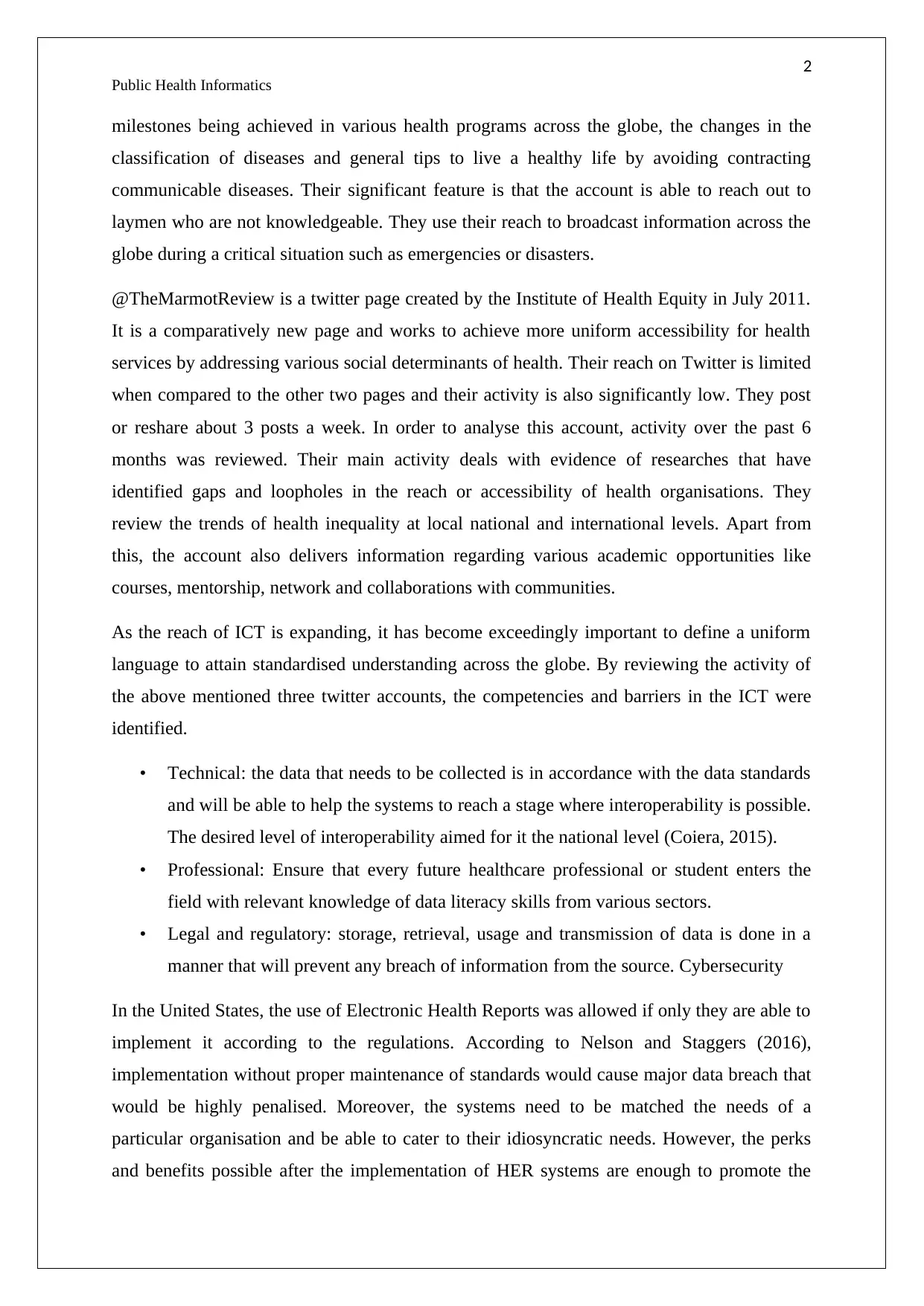
2
Public Health Informatics
milestones being achieved in various health programs across the globe, the changes in the
classification of diseases and general tips to live a healthy life by avoiding contracting
communicable diseases. Their significant feature is that the account is able to reach out to
laymen who are not knowledgeable. They use their reach to broadcast information across the
globe during a critical situation such as emergencies or disasters.
@TheMarmotReview is a twitter page created by the Institute of Health Equity in July 2011.
It is a comparatively new page and works to achieve more uniform accessibility for health
services by addressing various social determinants of health. Their reach on Twitter is limited
when compared to the other two pages and their activity is also significantly low. They post
or reshare about 3 posts a week. In order to analyse this account, activity over the past 6
months was reviewed. Their main activity deals with evidence of researches that have
identified gaps and loopholes in the reach or accessibility of health organisations. They
review the trends of health inequality at local national and international levels. Apart from
this, the account also delivers information regarding various academic opportunities like
courses, mentorship, network and collaborations with communities.
As the reach of ICT is expanding, it has become exceedingly important to define a uniform
language to attain standardised understanding across the globe. By reviewing the activity of
the above mentioned three twitter accounts, the competencies and barriers in the ICT were
identified.
• Technical: the data that needs to be collected is in accordance with the data standards
and will be able to help the systems to reach a stage where interoperability is possible.
The desired level of interoperability aimed for it the national level (Coiera, 2015).
• Professional: Ensure that every future healthcare professional or student enters the
field with relevant knowledge of data literacy skills from various sectors.
• Legal and regulatory: storage, retrieval, usage and transmission of data is done in a
manner that will prevent any breach of information from the source. Cybersecurity
In the United States, the use of Electronic Health Reports was allowed if only they are able to
implement it according to the regulations. According to Nelson and Staggers (2016),
implementation without proper maintenance of standards would cause major data breach that
would be highly penalised. Moreover, the systems need to be matched the needs of a
particular organisation and be able to cater to their idiosyncratic needs. However, the perks
and benefits possible after the implementation of HER systems are enough to promote the
Public Health Informatics
milestones being achieved in various health programs across the globe, the changes in the
classification of diseases and general tips to live a healthy life by avoiding contracting
communicable diseases. Their significant feature is that the account is able to reach out to
laymen who are not knowledgeable. They use their reach to broadcast information across the
globe during a critical situation such as emergencies or disasters.
@TheMarmotReview is a twitter page created by the Institute of Health Equity in July 2011.
It is a comparatively new page and works to achieve more uniform accessibility for health
services by addressing various social determinants of health. Their reach on Twitter is limited
when compared to the other two pages and their activity is also significantly low. They post
or reshare about 3 posts a week. In order to analyse this account, activity over the past 6
months was reviewed. Their main activity deals with evidence of researches that have
identified gaps and loopholes in the reach or accessibility of health organisations. They
review the trends of health inequality at local national and international levels. Apart from
this, the account also delivers information regarding various academic opportunities like
courses, mentorship, network and collaborations with communities.
As the reach of ICT is expanding, it has become exceedingly important to define a uniform
language to attain standardised understanding across the globe. By reviewing the activity of
the above mentioned three twitter accounts, the competencies and barriers in the ICT were
identified.
• Technical: the data that needs to be collected is in accordance with the data standards
and will be able to help the systems to reach a stage where interoperability is possible.
The desired level of interoperability aimed for it the national level (Coiera, 2015).
• Professional: Ensure that every future healthcare professional or student enters the
field with relevant knowledge of data literacy skills from various sectors.
• Legal and regulatory: storage, retrieval, usage and transmission of data is done in a
manner that will prevent any breach of information from the source. Cybersecurity
In the United States, the use of Electronic Health Reports was allowed if only they are able to
implement it according to the regulations. According to Nelson and Staggers (2016),
implementation without proper maintenance of standards would cause major data breach that
would be highly penalised. Moreover, the systems need to be matched the needs of a
particular organisation and be able to cater to their idiosyncratic needs. However, the perks
and benefits possible after the implementation of HER systems are enough to promote the
⊘ This is a preview!⊘
Do you want full access?
Subscribe today to unlock all pages.

Trusted by 1+ million students worldwide
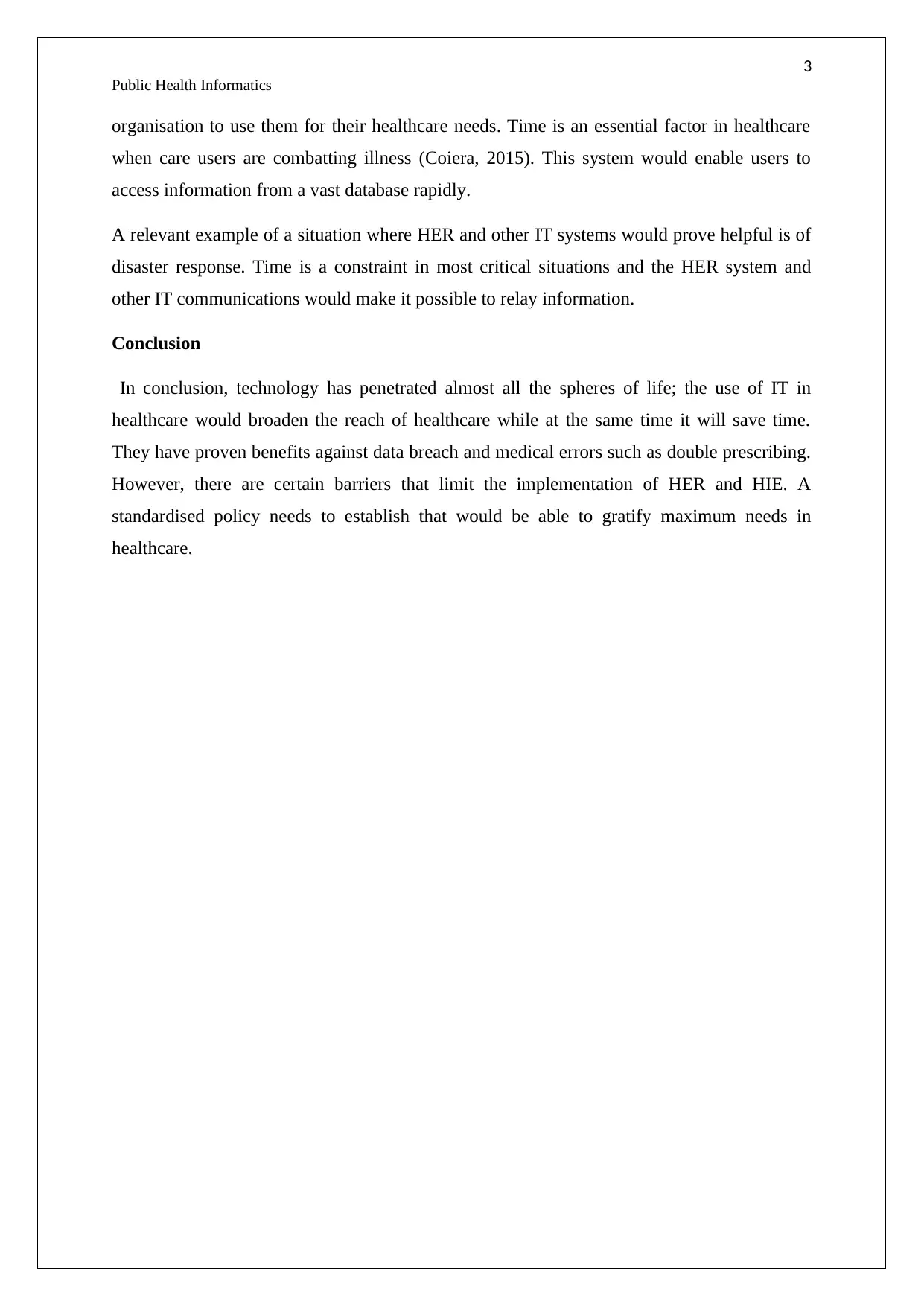
3
Public Health Informatics
organisation to use them for their healthcare needs. Time is an essential factor in healthcare
when care users are combatting illness (Coiera, 2015). This system would enable users to
access information from a vast database rapidly.
A relevant example of a situation where HER and other IT systems would prove helpful is of
disaster response. Time is a constraint in most critical situations and the HER system and
other IT communications would make it possible to relay information.
Conclusion
In conclusion, technology has penetrated almost all the spheres of life; the use of IT in
healthcare would broaden the reach of healthcare while at the same time it will save time.
They have proven benefits against data breach and medical errors such as double prescribing.
However, there are certain barriers that limit the implementation of HER and HIE. A
standardised policy needs to establish that would be able to gratify maximum needs in
healthcare.
Public Health Informatics
organisation to use them for their healthcare needs. Time is an essential factor in healthcare
when care users are combatting illness (Coiera, 2015). This system would enable users to
access information from a vast database rapidly.
A relevant example of a situation where HER and other IT systems would prove helpful is of
disaster response. Time is a constraint in most critical situations and the HER system and
other IT communications would make it possible to relay information.
Conclusion
In conclusion, technology has penetrated almost all the spheres of life; the use of IT in
healthcare would broaden the reach of healthcare while at the same time it will save time.
They have proven benefits against data breach and medical errors such as double prescribing.
However, there are certain barriers that limit the implementation of HER and HIE. A
standardised policy needs to establish that would be able to gratify maximum needs in
healthcare.
Paraphrase This Document
Need a fresh take? Get an instant paraphrase of this document with our AI Paraphraser
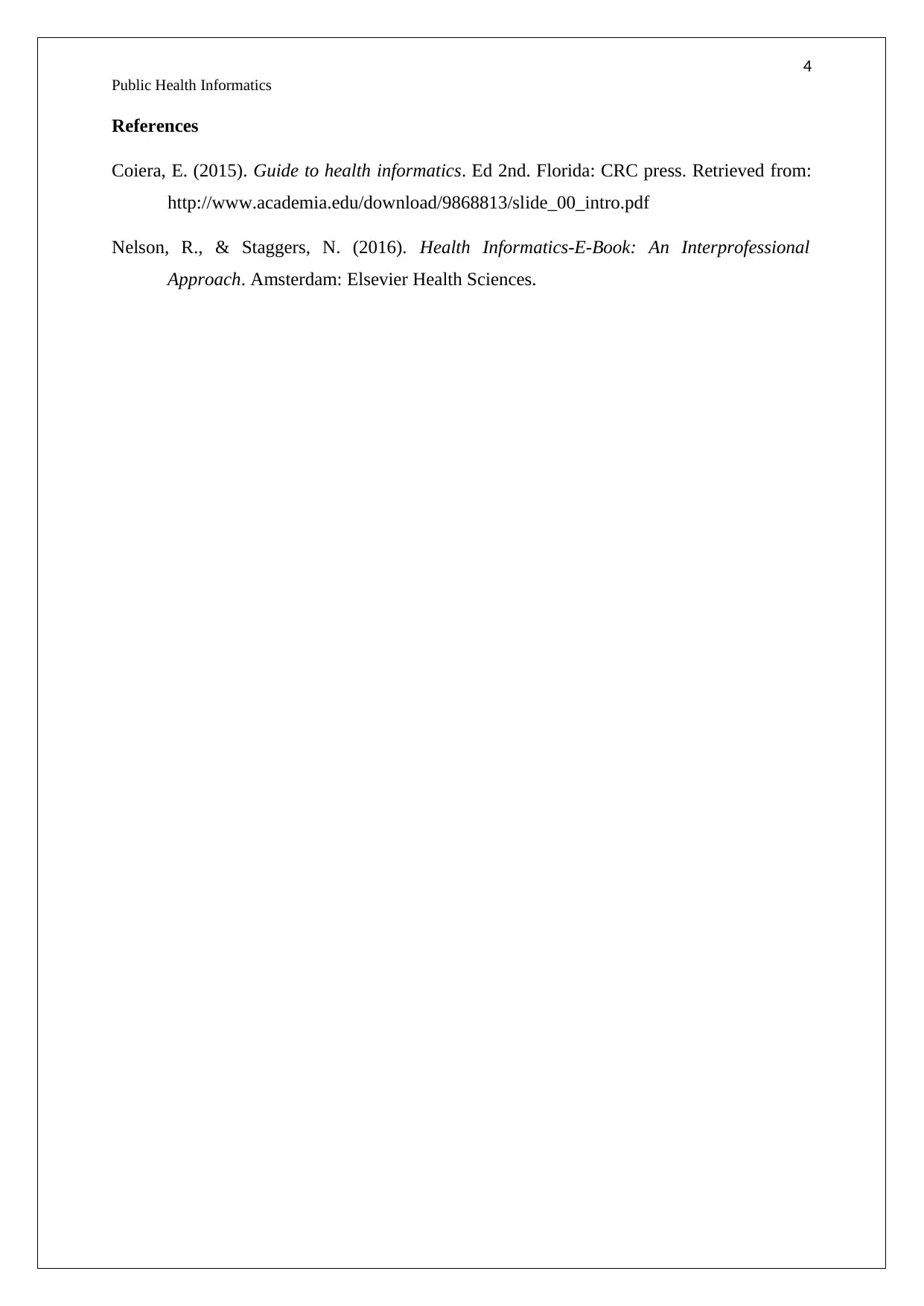
4
Public Health Informatics
References
Coiera, E. (2015). Guide to health informatics. Ed 2nd. Florida: CRC press. Retrieved from:
http://www.academia.edu/download/9868813/slide_00_intro.pdf
Nelson, R., & Staggers, N. (2016). Health Informatics-E-Book: An Interprofessional
Approach. Amsterdam: Elsevier Health Sciences.
Public Health Informatics
References
Coiera, E. (2015). Guide to health informatics. Ed 2nd. Florida: CRC press. Retrieved from:
http://www.academia.edu/download/9868813/slide_00_intro.pdf
Nelson, R., & Staggers, N. (2016). Health Informatics-E-Book: An Interprofessional
Approach. Amsterdam: Elsevier Health Sciences.
1 out of 5
Related Documents
Your All-in-One AI-Powered Toolkit for Academic Success.
+13062052269
info@desklib.com
Available 24*7 on WhatsApp / Email
![[object Object]](/_next/static/media/star-bottom.7253800d.svg)
Unlock your academic potential
Copyright © 2020–2025 A2Z Services. All Rights Reserved. Developed and managed by ZUCOL.




